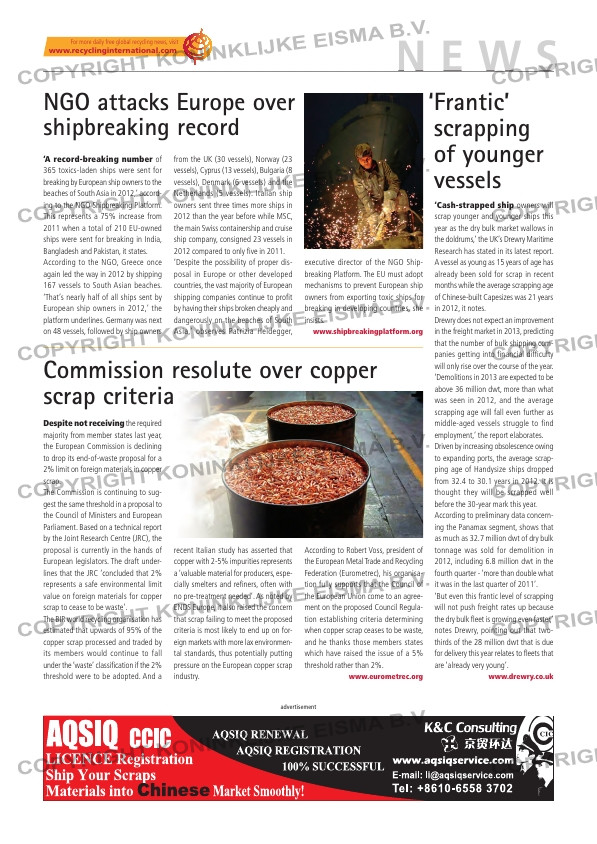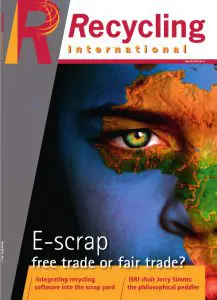Page 19 from: March 2013

N E W S
For more daily free global recycling news, visit
www.recyclinginternational.com
advertisement
‘A record-breaking number of
365 toxics-laden ships were sent for
breaking by European ship owners to the
beaches of South Asia in 2012,’ accord-
ing to the NGO Shipbreaking Platform.
This represents a 75% increase from
2011 when a total of 210 EU-owned
ships were sent for breaking in India,
Bangladesh and Pakistan, it states.
According to the NGO, Greece once
again led the way in 2012 by shipping
167 vessels to South Asian beaches.
‘That’s nearly half of all ships sent by
European ship owners in 2012,’ the
platform underlines. Germany was next
on 48 vessels, followed by ship owners
from the UK (30 vessels), Norway (23
vessels), Cyprus (13 vessels), Bulgaria (8
vessels), Denmark (6 vessels) and the
Netherlands (5 vessels). Italian ship
owners sent three times more ships in
2012 than the year before while MSC,
the main Swiss containership and cruise
ship company, consigned 23 vessels in
2012 compared to only fi ve in 2011.
‘Despite the possibility of proper dis-
posal in Europe or other developed
countries, the vast majority of European
shipping companies continue to profi t
by having their ships broken cheaply and
dangerously on the beaches of South
Asia,’ observes Patrizia Heidegger,
executive director of the NGO Ship-
breaking Platform. The EU must adopt
mechanisms to prevent European ship
owners from exporting toxic ships for
breaking in developing countries, she
insists.
www.shipbreakingplatform.org
NGO attacks Europe over
shipbreaking record
Despite not receiving the required
majority from member states last year,
the European Commission is declining
to drop its end-of-waste proposal for a
2% limit on foreign materials in copper
scrap.
The Commission is continuing to sug-
gest the same threshold in a proposal to
the Council of Ministers and European
Parliament. Based on a technical report
by the Joint Research Centre (JRC), the
proposal is currently in the hands of
European legislators. The draft under-
lines that the JRC ‘concluded that 2%
represents a safe environmental limit
value on foreign materials for copper
scrap to cease to be waste’.
The BIR world recycling organisation has
estimated that upwards of 95% of the
copper scrap processed and traded by
its members would continue to fall
under the ‘waste’ classifi cation if the 2%
threshold were to be adopted. And a
recent Italian study has asserted that
copper with 2-5% impurities represents
a ‘valuable material for producers, espe-
cially smelters and refi ners, often with
no pre-treatment needed’. As noted by
ENDS Europe, it also raised the concern
that scrap failing to meet the proposed
criteria is most likely to end up on for-
eign markets with more lax environmen-
tal standards, thus potentially putting
pressure on the European copper scrap
industry.
According to Robert Voss, president of
the European Metal Trade and Recycling
Federation (Eurometrec), his organisa-
tion fully supports that the Council of
the European Union come to an agree-
ment on the proposed Council Regula-
tion establishing criteria determining
when copper scrap ceases to be waste,
and he thanks those members states
which have raised the issue of a 5%
threshold rather than 2%.
www.eurometrec.org
‘Cash-strapped ship owners will
scrap younger and younger ships this
year as the dry bulk market wallows in
the doldrums,’ the UK’s Drewry Maritime
Research has stated in its latest report.
A vessel as young as 15 years of age has
already been sold for scrap in recent
months while the average scrapping age
of Chinese-built Capesizes was 21 years
in 2012, it notes.
Drewry does not expect an improvement
in the freight market in 2013, predicting
that the number of bulk shipping com-
panies getting into fi nancial diffi culty
will only rise over the course of the year.
‘Demolitions in 2013 are expected to be
above 36 million dwt, more than what
was seen in 2012, and the average
scrapping age will fall even further as
middle-aged vessels struggle to find
employment,’ the report elaborates.
Driven by increasing obsolescence owing
to expanding ports, the average scrap-
ping age of Handysize ships dropped
from 32.4 to 30.1 years in 2012. It is
thought they will be scrapped well
before the 30-year mark this year.
According to preliminary data concern-
ing the Panamax segment, shows that
as much as 32.7 million dwt of dry bulk
tonnage was sold for demolition in
2012, including 6.8 million dwt in the
fourth quarter – ‘more than double what
it was in the last quarter of 2011’.
‘But even this frantic level of scrapping
will not push freight rates up because
the dry bulk fl eet is growing even faster,’
notes Drewry, pointing out that two-
thirds of the 28 million dwt that is due
for delivery this year relates to fl eets that
are ‘already very young’.
www.drewry.co.uk
Commission resolute over copper
scrap criteria
‘ Frantic’
scrapping
of younger
vessels
RI_2-NEWS.indd 19 06-03-13 09:35



